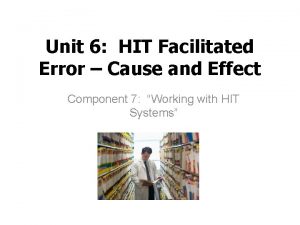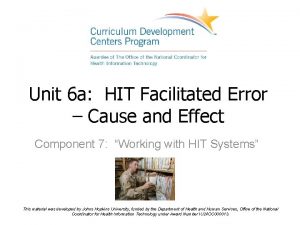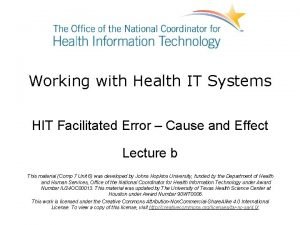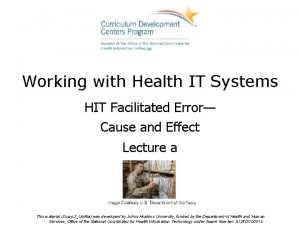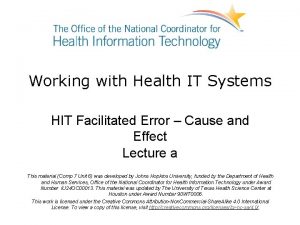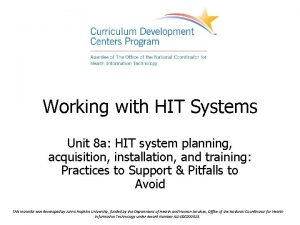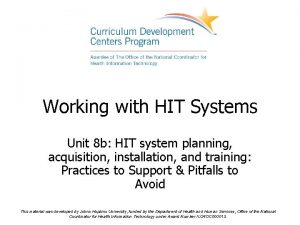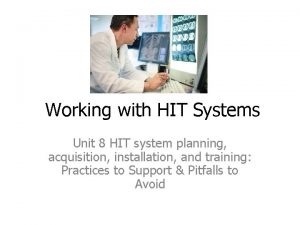Working With HIT Systems HIT Facilitated Error Cause













- Slides: 13

Working With HIT Systems HIT Facilitated Error – Cause and Effect Unit 3 -1 This work is licensed under a Creative Commons Attribution-Non. Commercial-Share. Alike 4. 0 International License. Based on a work at https: //www. healthit. gov/. This workforce product was funded by a grant awarded by the U. S. Department of Labor's Employment and Training Administration. The product was created by the grantee and does not necessarily reflect the official position of the U. S. Department of Labor. The Department of Labor makes no guarantees, warranties, or assurances of any kind, express or implied, with respect to such information, including any information on linked sites and including, but not limited to, accuracy of the information or its completeness, timeliness, usefulness, adequacy, continued availability, or ownership.

Error in Healthcare • High Stress – Distraction - Busy • Cognitive Limitations • Stuck in Thinking • Unclear Directions • Unclear Labeling/Poor Layout – Juxtaposition ‘‘I was ordering Cortisporin, and Cortisporin solution and suspension comes up. The patient was talking to me, I accidentally put down solution, realized that’s not what I wanted. . I would not have made that mistake, or potential mistake, if I had been writing it out because I would have put down what I wanted’’

Error in Healthcare

This slide contains a link to a video from You. Tube that illustrates an avoidable medical error involving the Quaid twins. The link below was accurate as of October, 2017. A GOOGLE search on the Quaid twins and medication error will result in numerous links to this particular news item. https: //youtu. be/XEbf 9 bli. Ous

Look at these bottles (RED ARROWS)– I can easily see how someone could have mixed them up.

Error in Healthcare • Role Change/Communication Change/Workflow Change • Undue Trust? • Currency & Appropriateness • Alert Fatigue • System Rigidity

Error Vocabulary • Omission • Commission • Slips/Lapses • Mistakes

Error Vocabulary Omission is an “error which occurs as a result of an action not taken, for example, when a delay in performing an indicated cesarean section results in a fetal death, when a nurse omits a dose of a medication that should be administered, or when a patient suicide is associated with a lapse in carrying out frequent patient checks in a psychiatric unit. Errors of omission may or may not lead to adverse outcomes. ”

Error Vocabulary Commission is an “error which occurs as a result of an action taken. Examples include when a drug is administered at the wrong time, in the wrong dosage, or using the wrong route; surgeries performed on the wrong side of the body; and transfusion errors involving blood crossmatched for another patient. “

Error Vocabulary Mistakes reflect failures from incorrect choices, rather than lapses (or slips) in concentration. Mistakes typically involve insufficient knowledge, failure to correctly interpret available information, or application of the wrong rule. Thus, choosing the wrong diagnostic test or ordering a suboptimal medication for a given condition represent mistakes. A slip, on the other hand, would be forgetting to check the chart to make sure you ordered them for the right patient – or starting to reconstitute a medication and realizing you grabbed the wrong one – and then you throw it away. Usually slips are caught whereas mistakes generally occur.

Error Vocabulary Distinguishing slips from mistakes serves two important functions. First, the risk factors for their occurrence differ. Slips occur in the face of competing sensory or emotional distractions, fatigue, and stress; mistakes more often reflect lack of experience or insufficient training. Second, the appropriate responses to these error types differ. Reducing the risk of slips requires attention to the designs of protocols, devices, and work environments— using checklists so key steps will not be omitted, reducing fatigue among personnel (or shifting high-risk work away from personnel who have been working extended hours), removing unnecessary variation in the design of key devices, eliminating distractions (e. g. , phones) from areas where work requires intense concentration, and other redesign strategies. A strategy that is being tested involves the cone of silence – similar to that of pilots on take off and landing – so for example when drugs are being mixed, measured, administered – no one interrupts the person doing the activity. Reducing the likelihood of mistakes typically requires more training or supervision. Even in the many cases of slips, health care has typically responded to all errors as if they were mistakes, with remedial education and/or added layers of supervision. In reality, the more appropriate action is to look at the design that encourages the slips. More education will not help faulty design.

Addressing the Issue “Human Factors” Ergonomics (or human factors) is the scientific discipline concerned with the understanding of interactions among humans and other elements of a system, and the profession that applies theory, principles, data, and other methods to design in order to optimize human well-being and overall system performance. Human Factors in Surgery Video From the Mayo Clinic http: //www. youtube. com/watch? v=x. R 78 d. XTYy 9 c

Finishing out – Helping to Avoid Error In HIT • Computer screens/layouts/systems that are: – Easy to read – Easy to understand – Logical – Support cognition – not thwart – Agile & flexible – Help to prevent error – Make the right thing the easiest thing This material was developed by Johns Hopkins University, funded by the Department of Health and Human Services, Office of the National Coordinator for Health Information Technology under Award Number IU 24 OC 000013. This material was updated in 2016 by The University of Texas Health Science Center at Houston under Award Number 90 WT 0006. http: //creativecommons. org/licenses/by-nc-sa/4. 0/.
 Smart vs hard working
Smart vs hard working Hot working of metals is carried out
Hot working of metals is carried out Hot working and cold working difference
Hot working and cold working difference Machining operations
Machining operations Pengerjaan panas
Pengerjaan panas Lesson 2 working for a cause
Lesson 2 working for a cause Does exocytosis require energy
Does exocytosis require energy Diffusion in nature
Diffusion in nature Kjs_1999
Kjs_1999 Facilitated risk analysis process
Facilitated risk analysis process Plant cells isotonic
Plant cells isotonic Simple diffusion
Simple diffusion Facilitated collection
Facilitated collection Types of diffusion
Types of diffusion














